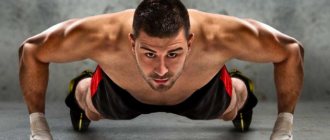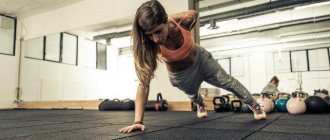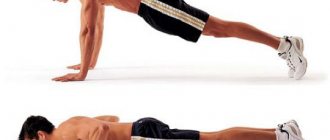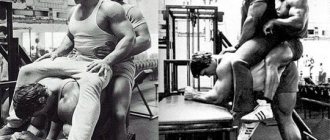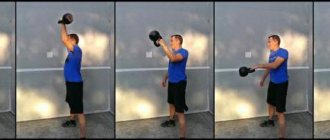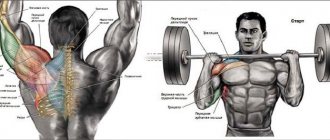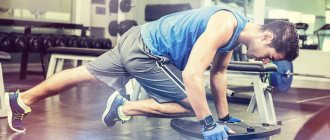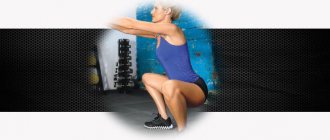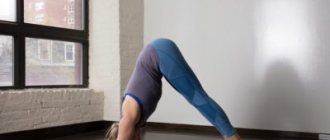Crossfit with kettlebells
The peculiarity of CrossFit is the combination of different types of load and work with different equipment. This discipline also has elements of kettlebell lifting. In classic Russian kettlebells, only two competitive movements are performed - the snatch and the clean and jerk. CrossFit borrowed them, and everything that Pavel Tsatsouline recommends to his clients - kettlebell swings, long cycle pushes, goblet squats, and different types of lunges. Exercises with a kettlebell for a beginner can develop strength, but for those who are continuing and aspiring to compete in CrossFit competitions, they are designed to build strength endurance.
Basic exercises with kettlebells in CrossFit
The specificity of this sport is that there is no approved list of movements. The CrossFit motto is “Prepare for the unknown.” Kettlebell exercises are selected based on the principle of greatest prevalence and accessibility to people with any level of training. The main ones for mastering the complexes are the following.
Swings or Swings
There are two types of kettlebell swing - “show the judge your ears”, or a swing with both hands behind the head, and the usual “Russian swing”, that is, a swing to waist level. A beginner begins to master the exercises from the second option. He stands in a stance that is convenient for deadlifts and squats, turns his socks around, places the weight between his legs strictly in the center, grabs the handle with a direct grip, and removes the weight from the platform by extending the knee joints. Next, he swings between the legs and sharply straightens the hip and knee joints. By inertia, the weight flies out to waist level. Then the movement is repeated. This exercise is used both for strength endurance and to strengthen the buttocks, back, and back of the thighs.
“Show the judge your ears” or “American swing” requires the ability to use both hands at the same time, good shoulder mobility, and explosive power. The lifting technique is the same; it is important to maintain the adducted shoulder blades and a tense, arched position of the back. The exercise requires activation of not only the posterior chain, but also the shoulders, so it is recommended for everyone with normal joint mobility.
When can you start training?
The big mistake everyone makes when starting to practice this system is haste.
https://youtu.be/jAoRNTSwS20
All exercises should be performed in a circular fashion without stopping. This often leads to the fact that an underdeveloped athlete begins to perform the approach technique incorrectly, which is why he gets injured.
Experts do not recommend starting CrossFit on their own for beginners who can hardly do 20 pull-ups and run 500 meters at an average pace.
A CrossFit training program for beginners should be drawn up by an experienced trainer who has an understanding of this system.
Complexes with kettlebells from CrossFit
These workouts appeared on the main page of the official CrossFit website, and were quite popular.
"Dirty 50 with a Kettlebell"
The focus of the complex is strength endurance and general physical fitness. You need to perform 50 repetitions of each exercise, moving from one to another. It is not forbidden to break the complex into parts, that is, perform it in 5 circles of 10 repetitions.
- Pull-up (rubber or kipping);
- Classic deadlift (guys 60 kg, girls 40 kg);
- Push-ups with palms raised (classic for CrossFit, you need to lie on the floor and raise your palms);
- Swings or swings, full (24 and 16 kg, respectively);
- Classic squats with a barbell (60 or 40);
- Raising the knees to the elbows while hanging on the horizontal bar;
- Thrusters with dumbbells or kettlebells (16 and 8, respectively);
- Lunges, weights at the top (the sequence is the same);
- Burpee with jump
It is forbidden to switch movements or perform them with too much rest. The option with crushing and rest is, in principle, considered non-competitive, “beginner”. If the complex takes more than an hour, you should stop and proceed to a cool-down.
https://youtu.be/BIX7mMcZtgc
"Lazy"
This is a strength complex, men do it with two-pound weights, women with one-pound weights. Beginners can use 8 kg.
Do it with both hands:
- 50 repetitions of the push;
- The same number of jerks;
- The same number of kettlebell swings
Important – you can do 25 with each hand; if you don’t feel strong enough to complete the complex, reduce the weight, but don’t stop. Professional athletes can complete this complex in 5 minutes.
300 or "Three Hundred Spartans"
This complex must be performed as prescribed, without changing movements. Doing it in circles is prohibited. Beginners can vary the exercises as above.
- 25 pull-ups (kipping, or rubber), beginners can replace with negative pull-ups - from a chest jump to the bar, plus a slow lowering, then 5 repetitions are performed;
- 50 classic deadlifts, 60 kg, or less weight if the athlete is not physically ready. Deadlifts are performed from large plates or a plinth, and not from short “fitness” plates;
- 50 push-ups with arm raises. Those who cannot do push-ups can do a complex with a bench, but you should strive for the usual classical technique;
- 50 box jumps 60 or 75 cm;
- 50 “climbers”;
- 25 kettlebell pushes from the floor from each hand, 24 and 16 kg, respectively;
- Again 25 pull-ups, same load adaptation
"Georgie"
This routine is fairly short and can be done with minimal equipment, which doesn't mean it's only suitable for beginners. Experienced athletes should try to work in a high-speed, explosive manner to get the full benefits of the exercise.
As many rounds as possible within 21 minutes:
"Bloodlust"
This complex is also good for a runner’s general physical fitness.
Complete 5 rounds against the clock:
- Run 600 m;
- 40 Russian kettlebell swings;
- 20 squats without weight
Kettlebells are a practical choice for home training; they can become the only weight for the entire workout and allow you to develop explosive strength and endurance. Training with kettlebells is also suitable for fighters, runners, and representatives of team sports, as well as anyone who wants to build a “lean” shape with a minimum of excess fat.
https://youtu.be/IB89i7WSDCE
Features of working with projectiles
It is recommended to engage in a high-speed program with weights for those people whose bodies are ready for high physical activity. Because when exercising with light weights, you cannot quickly gain muscle mass. After all, the weight of dumbbells has certain limitations; they are usually very light. But the weight of the kettlebell varies from 4 kilograms to 32, usually in many gyms the maximum weight of kettlebells is 16 kg.
The 16-kilogram projectile is ideal for those men and women who want to get their body in order and increase their endurance.
The most convenient weights are dumbbells, but their weight is usually not enough to thoroughly pump the muscles.
They are used only for weight loss and restoring muscle tone. Therefore, a person who wants to pump up his muscles can only work with either a barbell or a kettlebell.
Working out with a barbell is quite difficult, so beginners are recommended to use kettlebells. Beginners are advised to start training with a minimum kettlebell weight, gradually increasing it to 16 kilograms for women and 32 kilograms for men.
The kettlebell is an almost ideal apparatus for developing the body's strength endurance. Exercises with this apparatus allow you to develop almost all muscle groups. At the same time, the kettlebell is not a technically complex piece of equipment. You can master the correct technique for lifting it in just a couple of lessons!
Crossfit workouts and exercises with kettlebells
It is known that CrossFit includes several sports areas - one of them is kettlebell lifting. In this material, we have prepared for you the best CrossFit exercises with kettlebells, as well as examples of workouts and WOD complexes.
Kettlebells are an excellent sports equipment and it is difficult to overestimate their importance for CrossFit training. Nevertheless, in a full-fledged complex it is quite difficult to manage with them alone, but if you use them as an auxiliary tool, the effect will be simply wonderful. Therefore, our recommendation is not to neglect exercises with kettlebells in your training!
Crossfit exercises with kettlebells
Let's not beat around the bush and get straight to the point. A selection of the most effective CrossFit exercises with kettlebells. Go!
Kettlebell swings
There are several variations of kettlebell swings in CrossFit. We will focus on the classic version of the exercise - with both hands. Why is it needed? This is one of the basic exercises that involves several muscle groups at once: the core, hips, buttocks and back. In addition, the exercise perfectly develops explosive strength.
What you need to pay attention to:
- The key point is that your back should be straight at all times during the exercise. Don't slouch or droop your shoulders.
- Place your feet slightly wider than shoulder width.
- The movement occurs due to the extension of the legs and back - the arms in this exercise act as a lever (they should experience virtually no load).
- There are several casting options - from eye level to overhead position. There is no fundamental difference here, with the exception that in the second option you additionally load your shoulders and work on body coordination (the option is a little more energy-consuming).
https://youtu.be/HSTreJWu6N0
Kettlebell push (short amplitude)
The kettlebell push exercise, unlike swings, works the following muscles: legs, long back muscles, shoulders, pectoralis major, triceps, biceps and forearms. The kettlebell push, like many other exercises, has several variations - we will focus on the version with a short range of motion.
- Starting position: legs slightly wider than shoulders, fully straightened and relaxed, arms folded on the chest - wrists facing each other.
- The start of the exercise begins with the legs - you do a shallow squat to accelerate; the body leans back slightly (so that the support for the projectiles is your chest, not your arms).
- Next, you must make a powerful push with your legs and back in such a way that at the top point of acceleration you stand up slightly on your toes.
- Next, the amplitude of the movement of accelerating the weights continues with the help of your arms and shoulders, at the same time you seem to sit under the apparatus. As a result, you should find yourself in a half-squat position with your arms extended above your head (Figure 4).
- Next, you complete the exercise by fully straightening with your legs. The arms remain straight above the head.
The most common mistake when performing a two-handed push is to push the weight with your hands first and, as a result, fix the weight above your head with your arms not straightened. This approach, especially with heavy weights, is fraught with injury.
Kettlebell Front Squats
Often in CrossFit exercises, kettlebells are used as weights for already familiar gymnastic exercises - for example, classic squats. There are several variations of this exercise - with two, with one at the chest, with outstretched arms and with lowering the weight to the floor. We will focus on the classic version - squats with a kettlebell at the chest.
The technique of performing the exercise is similar to classic squats. Important:
- Starting position – legs slightly wider than shoulders, the projectile pressed tightly to the chest in two hands.
- When performing a squat, do not forget to try to move your pelvis back, keep your back straight, and also keep the apparatus as close to your chest as possible.
Exercise technique:
- Starting position – feet shoulder-width apart, arms perpendicular to the floor, back straight, looking straight ahead.
- Next, we lunge with one leg: the position of the arms remains unchanged, the back is straight (do not fall forward), and the knee gently touches the floor.
https://youtu.be/3BgRciIyzW4
Kettlebell row to the chin from a squat
And the final exercise we’ll talk about today is the kettlebell row from a squat. This exercise is also regularly used in CrossFit training programs.
It’s quite simple to do, let’s look at the technique step by step:
- Starting position: squat, legs wider than shoulders, back straight, looking straight ahead. Both hands are below, located slightly in front of the legs exactly in the middle.
- We make a powerful jerk using our legs and back, and at the same time we pull the projectile to the chin by spreading our arms. Palms and elbows should be at shoulder level. (no need to go higher, lower too).
This exercise actively involves the muscles of the legs, back, shoulders and triceps.
https://youtu.be/EMhNlh5B4D4
Let's watch the video of all the best CrossFit exercises with kettlebells! 34 pieces:
https://youtu.be/yulAKyL_RgI
Crossfit workouts and complexes with weights
We have selected for you the most interesting CrossFit workouts and complexes with weights. Let's not waste time - let's go!
Complex: Funbobbys Filthy 50
The name of the workout speaks for itself - the complex is definitely fun
The task is to do each exercise 50 times:
- Pull-ups;
- Deadlift (60/40 kg);
- Push ups;
- Kettlebell swings (24 kg/16 kg) ;
- Barbell back squats (60/40 kg);
- Knees to elbows;
- Dumbbell throws (16/8 kg each);
- Lunges with dumbbells (16/8 kg each);
- Burpee.
Important: you cannot split or swap exercises in a complex! The lead time is until you do it. The average execution time for athletes is 30-60 minutes, depending on preparation.
Complex: Lazy
The task within the training is to do each type of exercise 50 times:
- Kettlebell snatches (25+25);
- Kettlebell pushes (25+25);
- Kettlebell swings (you set the weight yourself).
The complex has maximum strength and explosiveness. We'll have to sweat. The average execution time for athletes is 5-20 minutes, depending on preparation.
Complex: 300 Spartans
As part of the training, the task is to do the following exercises:
- 25 pull-ups;
- 50 deadlifts 60kg;
- 50 push-ups;
- 50 jumps on a pedestal 60-75cm;
- 50 polishers (touch both sides = 1 time);
- Take 50 pushes of a weight (dumbbell) from the floor. 24/16 kg (25+25) ;
- 25 pull-ups.
Attention: you cannot break the complex and change the exercises in places! The average execution time for athletes is 5-20 minutes, depending on preparation.
https://youtu.be/zLaNfTgP2g8
Complex: WOD footprint
The task within the training is as follows: perform all exercises 50 times each (without changing the order or breaking them up):
- Deadlift (minus 30% of body weight);
- Pushups;
- Kettlebell swings (minus 70% of body weight) ;
- Pull-ups;
- Cleans and lunges (minus 50% of body weight);
- Jumping on a box;
- Group knees to elbows on the floor (legs and arms straight);
- Double jumping rope.
Complex: The bell from hell
Well, and finally, the killer complex. Only 1 round at a time, do not change exercises. Training task (where weights are not indicated - adjust to suit yourself):
- 53 mach (24 kg);
- 200 m of penetration with two weights on outstretched arms;
- 53 sumo row to the chin;
- 150m penetration with two weights on outstretched arms;
- 53 Snatch of two weights;
- 100m penetration with two weights;
- 53 Kettlebell Extensions;
- 50m penetration with weights.
The average execution time for athletes is 30-45 minutes, depending on preparation.
As you can see, this is quite a practical sports equipment and perfectly complements CrossFit complexes, and sometimes it can be completely 1 single weight for the entire workout. If you liked the material, share it with your friends. Questions and suggestions in the comments!
How exercise affects the muscles of the body
It is no exaggeration that the above complex includes the best exercises. If you perform such a complex at least every other day, the result will be very fast. Naturally, the magnitude of the load must also be taken into account. Especially when you increase the weight of the projectile. Take time to rest and organize proper sports nutrition.
Squats with weights are great for training your leg muscles. A regular squat uses only your own body weight, but simple squats performed regularly will make your legs beautiful and strong. How much does the result improve if you squat with weights, gradually increasing the load? Experts say that the result improves by 70%.
High lift deadlifts train the muscles in the shoulder girdle and arms. They are the ones who work when the weight is pulled to the chest. Endurance improves, because the exercise is performed with synchronization of movements and breathing. However, this can be attributed to each of the exercises in this complex.
The Romanian deadlift trains the arm muscles. Due to the tilt of the body, the lower back is also affected. She is strengthening.
Kettlebell swings are a very ancient exercise that was used by ancient warriors. Develops hand strength and coordination of movements. Such training has long helped people become better at wielding edged weapons. As an option, advanced kettlebell lifters release the kettlebell from their hands during the swing, spinning it in the air, and then catch it.
Cleans and kettlebell presses train your arm muscles. We can say that none of the known exercises has such an effect on absolutely all the muscles of the arm. The hands, elbow joint, and shoulder girdle are strengthened.
The Renegade Row is a unique exercise that develops both muscle and coordination. The athlete has to balance on one hand. In the advanced version, the hand rests not on the floor, but on the handle of the second weight standing on the floor.
The given set of exercises for CrossFit with kettlebells is unique. Be sure to include it in your training programs. By training regularly using this method, an athlete is able to significantly improve his results in this sport, which has become so popular.
A set of exercises with a kettlebell
Squats with a row to the chin
- Place your feet slightly wider than your shoulders and point your toes out to the sides.
- Hold the bar of the kettlebell with both hands.
- As you inhale, squat until parallel to the floor, move your pelvis back.
- Touch the kettlebell to the floor in the bottom squat position.
- As you exhale, rise up and in the middle of the movement, pull the weight to your chin, elbows up.
- As you inhale, repeat the squat and lower the weight with straight arms.
Deep squats on a hill
- Stand with your feet elevated and hold the kettlebell with both hands.
- As you inhale, lower your pelvis as low as your knees.
- Touch the weights to the floor and exhale as you straighten your torso.
- Do not lean your body forward, look at the ceiling.
- Hold the kettlebell with straight arms.
Plie squats
- Place your feet wide and point your toes out to the sides.
- Hold the kettlebell with straight arms.
- As you inhale, lower your pelvis, knees pointing towards your toes.
- Lower your pelvis to a horizontal line with your knees, exhaling and rise up.
Lunges
For lunges, you need to hold a kettlebell in one straight arm above your head.
- Perform the exercise alternately on each side.
- Take the kettlebell in your right hand and hold it motionless above your head, maintaining balance. Don't bend your elbow.
- As you inhale, take a step forward with your right foot, and as you exhale, take it back.
- Once done on the right side, repeat the same on the left side.
Deadlift
- Feet shoulder width apart.
- Hold the kettlebell with straight arms.
- As you inhale, bend your torso with your back straight. Keep your knees straight.
- At the bottom, touch the weights to the floor and, exhaling, rise up, fully extending your torso.
Jumping
Perform with minimal weight.
- Place your feet slightly wider than your pelvis, and hold the handle of the weight with both straight hands.
- As you inhale, squat, moving your pelvis back, touching the weights to the floor.
- With an exhalation, use your legs to push off the floor and jump up, lifting your toes off last, and when landing, your toes touch the floor first.
- When your feet fully touch the floor, perform a squat.
- Hands are always straight. The back is not rounded. And jump out again.
Bent over row
- Feet shoulder width apart.
- Bend your knees forward at an angle of 45 degrees.
- Hold the kettlebell with both hands.
- As you exhale, pull the projectile towards your waist with your back muscles, bringing your shoulder blades together.
- As you inhale, straighten your elbows completely.
Kettlebell swings
Perform the exercise with inertia.
- Stand tall with your feet slightly wider than your pelvis.
- Swing your body, pushing your arms out with your pelvis so that the weight flies in the air to eye level.
- Exhale at the top.
- Falling back, the weight flies under the pelvis, the body bends over the weight and goes slightly into a squat.
- Inhale at the lowest point. And again push the weight out with your pelvis by inertia.
Pullover with weights
Performed while lying on a hill.
- You can hold the handle of the kettlebell with both hands with a direct grip from below, or parallel to the edges of the handle.
- With your elbows bent, hold the kettlebell above your chest.
- As you inhale, place the weight behind your head, without changing the angle of your elbows, stretch your pectoral muscles.
- As you exhale, return the weight to a vertical position.
Lifting weights while lying down
- Lie down on a bench with both weights in your hands.
- Hold the arms with an underhand grip, with the insides of your palms facing each other.
- The weights lie on the sides of the forearms.
- Elbows are slightly bent, looking to the sides.
- As you inhale, spread your arms to the sides, lowering them no lower than the shoulder joints, feel the stretching of the pectoral muscles.
- As you exhale, bring your arms back to a vertical position.
- The chest should be rounded.
Multi-height push-ups
- Start in a prone position with your arms wide, one hand holding the handle of the kettlebell, or lay it on your side with your palm on your core.
- Lower your chest as low as possible as you inhale, and exhale as you do push-ups.
- Swap your hands.
Narrow push-ups
You will need two weights, which must be placed apart from each other across the width of the shoulder joints. The arms should be turned parallel to each other.
- Grasp the apparatus and stand in a plank position (you can do it from your knees).
- As you inhale, lower your chest.
- Exhale and do push-ups.
You can also do one-kettlebell core push-ups with both hands while maintaining balance.
Extension of arms with a kettlebell from behind the head
- While standing or sitting, hold the kettlebell overhead with an underhand grip.
- In such a way that when the elbows are bent, the weight falls back, and the palms are located below the arch.
- Press your elbows to your head, and while inhaling, lower your hands to the back of your head.
- As you exhale, straighten your elbows completely and raise your arms to a vertical position.
Single Kettlebell Press
Lifting the weights is done while standing. The specificity of the exercise is that you need to hold on not to the arms, but to the sides of the core of the weight.
- Place your feet shoulder-width apart, hold the kettlebell tightly, with your elbows pointing down.
- As you exhale, push the weight over your head, holding the weight tightly in your palms.
- As you inhale, lower gently.
Kettlebell Front Raise
Unlike swings, it is not performed by inertia.
- The rise occurs in a concentrated manner.
- Place your feet firmly, shoulder-width apart.
- Hold the bar of one kettlebell with your hands, with your elbows slightly bent.
- As you exhale, raise the weight to eye level, and as you inhale, slowly lower it.
Seated kettlebell press
Performed with two kettlebells.
- While sitting, press your lower back into the bench.
- Raise the weights to your shoulders.
- The palms are turned away from you, the elbows are lowered to the floor, the weight touches the forearms.
- As you exhale, push the weights overhead into a vertical arms position, fully straightening your elbows. Brushes do not rotate.
- As you inhale, lower it smoothly.
You can also perform a single kettlebell press, the main thing is to maintain the center of gravity.
Standing kettlebell curl
You can perform biceps curls by holding the sides of the arms (with a parallel grip) or directly by the core of the kettlebell.
- Stand in a stable position, holding the kettlebell with your hands near your hips.
- As you exhale, bend your elbows, pressing the projectile closer to your chest.
- As you exhale, lower slowly, do not swing.
- The elbows remain in a stationary position.
Side bends
- Place your feet wider than your pelvis for stability.
- Take the weight in your right hand and place your free hand behind your head.
- As you inhale, bend to the right as far as your flexibility allows.
- Exhale as you straighten up.
- When bending over, feel the work of the oblique abdominal muscles on the right side.
- Repeat the same on the left side.
Raising the body with a kettlebell on the chest
You can hold the weight by the side handle or the round part.
- Lie on the floor, holding a kettlebell near your chest with both hands.
- If desired, your legs can be placed straight ahead and your knees bent.
- A heavier option is with straight legs.
- As you exhale, slowly twist, rounding your back, lift your spine completely off the floor.
- Without relaxing your abdominal muscles, slowly lower your back to the floor while inhaling slowly.
Turkish Rise
- Lying on your back, hold the weight vertically on your straight (right) arm.
- Bend your right leg.
- Press the weight and body upward with your abs, moving your left foot back.
- From a kneeling position, push off with your feet and lift the weight up, keeping the barbell vertical.
- And do the reverse movement in reverse order.
- Repeat the same number of repetitions on both sides.
Get under the bar as quickly as possible
Quickly getting under the bar is a scary part of any weightlifting exercise, so common sense tells you to get the bar as high as possible before diving and catching it. But the reality is that the longer you wait before going under the bar, the harder it will be for you to face it later.
“When I visited CrossFit gyms and watched people doing the snatch, I noticed that the most common mistake was to take too long in the snatch phase,” says Pendley. “In other words, after the bar reaches their hips, they continue to pull it up until the bar is already somewhere at chest or shoulder level, and only then they try to sit under it. But that's too high.
As soon as the bar leaves your thighs, you should immediately fall under it rather than continue to try to lift it higher. People pay too much attention to lifting the barbell, but not enough attention to diving under it - this happens in both the snatch and the clean. You just need to lift the barbell up to the level of your belly button so you can then clean it on your chest. The thighs are very strong. If you continue to pull the barbell up with your arms, then yes, you will lift it higher, but at the same time you will slow down, because your arms cannot produce as much force as your hips.”
Ilya Ilyin, a two-time Olympic champion and holder of world records in the clean and jerk and the sum of two exercises (w/c up to 94 kg), said the best thing about this topic in one of his videos: “It’s simple. He blew it up and fell like a stone.”
If this concept seems meaningless to you, then think about physics. When you snatch or clean, the barbell moves up from the ground, reaches its maximum height, and then drops back down until you meet it in the squat. If you wait too long before diving under it, then by the time you get under it, it will have already started its way down, in other words, it will have started falling. An object picks up speed as gravity pulls it down, so the longer the barbell falls, the faster it will move, and the harder it will be for you to meet it.
“Ideally, you should aim to meet the bar at the top of the pull while it has no momentum,” says Pendlay. “If the bar only goes down two or three inches, it is much easier to meet and hold it. And if by this moment it has already flown 18 inches, then it will be extremely difficult to meet and hold it. That’s why you have to start going under the bar while the bar is still moving up.”
Coaching Tips
Glenn has a simple tip for getting under the bar on time: when the bar reaches your hips, start swinging your legs. “I'm not using this tip because I think you should necessarily throw your legs out when doing a snatch,” he says. - "Not at all. But this is a great opportunity to teach beginners not to drag the barbell up for too long.
Because once your feet leave the ground, you can't keep lifting the barbell up. This is the most elementary physics. So maybe you should really make a rule that as soon as the bar reaches your hips, you lift your legs off. To do this, you should lift your feet off the floor at least a little. I don't tell my athletes to lift their legs too high because then they'll get carried away and lift them almost 12 inches, doing what they call a 'donkey kick' that shouldn't be happening."

